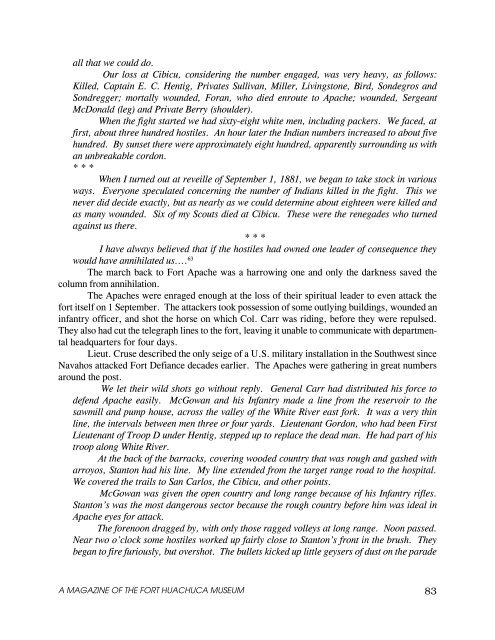Apache Campaigns - Fort Huachuca - U.S. Army
Apache Campaigns - Fort Huachuca - U.S. Army
Apache Campaigns - Fort Huachuca - U.S. Army
You also want an ePaper? Increase the reach of your titles
YUMPU automatically turns print PDFs into web optimized ePapers that Google loves.
all that we could do.<br />
Our loss at Cibicu, considering the number engaged, was very heavy, as follows:<br />
Killed, Captain E. C. Hentig, Privates Sullivan, Miller, Livingstone, Bird, Sondegros and<br />
Sondregger; mortally wounded, Foran, who died enroute to <strong>Apache</strong>; wounded, Sergeant<br />
McDonald (leg) and Private Berry (shoulder).<br />
When the fight started we had sixty-eight white men, including packers. We faced, at<br />
first, about three hundred hostiles. An hour later the Indian numbers increased to about five<br />
hundred. By sunset there were approximately eight hundred, apparently surrounding us with<br />
an unbreakable cordon.<br />
* * *<br />
When I turned out at reveille of September 1, 1881, we began to take stock in various<br />
ways. Everyone speculated concerning the number of Indians killed in the fight. This we<br />
never did decide exactly, but as nearly as we could determine about eighteen were killed and<br />
as many wounded. Six of my Scouts died at Cibicu. These were the renegades who turned<br />
against us there.<br />
* * *<br />
I have always believed that if the hostiles had owned one leader of consequence they<br />
would have annihilated us.... 63<br />
The march back to <strong>Fort</strong> <strong>Apache</strong> was a harrowing one and only the darkness saved the<br />
column from annihilation.<br />
The <strong>Apache</strong>s were enraged enough at the loss of their spiritual leader to even attack the<br />
fort itself on 1 September. The attackers took possession of some outlying buildings, wounded an<br />
infantry officer, and shot the horse on which Col. Carr was riding, before they were repulsed.<br />
They also had cut the telegraph lines to the fort, leaving it unable to communicate with departmental<br />
headquarters for four days.<br />
Lieut. Cruse described the only seige of a U.S. military installation in the Southwest since<br />
Navahos attacked <strong>Fort</strong> Defiance decades earlier. The <strong>Apache</strong>s were gathering in great numbers<br />
around the post.<br />
We let their wild shots go without reply. General Carr had distributed his force to<br />
defend <strong>Apache</strong> easily. McGowan and his Infantry made a line from the reservoir to the<br />
sawmill and pump house, across the valley of the White River east fork. It was a very thin<br />
line, the intervals between men three or four yards. Lieutenant Gordon, who had been First<br />
Lieutenant of Troop D under Hentig, stepped up to replace the dead man. He had part of his<br />
troop along White River.<br />
At the back of the barracks, covering wooded country that was rough and gashed with<br />
arroyos, Stanton had his line. My line extended from the target range road to the hospital.<br />
We covered the trails to San Carlos, the Cibicu, and other points.<br />
McGowan was given the open country and long range because of his Infantry rifles.<br />
Stanton’s was the most dangerous sector because the rough country before him was ideal in<br />
<strong>Apache</strong> eyes for attack.<br />
The forenoon dragged by, with only those ragged volleys at long range. Noon passed.<br />
Near two o’clock some hostiles worked up fairly close to Stanton’s front in the brush. They<br />
began to fire furiously, but overshot. The bullets kicked up little geysers of dust on the parade<br />
A MAGAZINE OF THE FORT HUACHUCA MUSEUM<br />
83

















